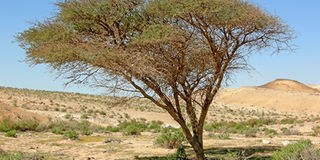You want a share of charcoal billions? Acacia is your tree

An acacia tree. This versatile tree has the ability to go into hibernation during dry seasons. It does this by first turning the colour of its leaves from green to purple and then dropping them off altogether. FILE PHOTO | NATION MEDIA GROUP
What you need to know:
- The acacia is so resilient that it can grow almost anywhere with minimal care.
- Because of its thorns, it is useful for security especially if planted on the home/farm perimeter.
- Mature acacias produce clusters of bright yellow, sweetly-scented flowers. They attract bees making the tree crucial in honey production.
- The government’s decisions are informed by the belief that the charcoal comes from public forests. This may not be entirely correct.
Yellow-barked acacia (Xanthophloea), which I have grown since 2014, is one of the most useful trees in Kenya today.
I have nearly 3,000 of them. The name ‘’xanthophloea’’ means “yellow bark” and refers to the yellow-green bark of the tree.
It is native to Africa. The first Europeans to travel to the continent also called it ‘Fever tree’ because they wrongly believed that it caused malaria.
The tree often grows in swampy areas or near water, which is breeding ground for the fever-carrying mosquitos. This made the Europeans to introduce another tree, the blue gum, to drain the swamps.
They called it the anti-fever tree. The acacia is so resilient that it can grow almost anywhere with minimal care.
Plant it in a swamp and it will take to life like a fish to water. Dry soils with little or no water? No problem, it will survive.
Deep roots make it thrive under dry conditions. It has the ability to go into hibernation during the dry seasons. This it does by first turning the colour of its leaves from green to purple and then dropping them off altogether.
Value of the acacia
Because of its thorns, it is useful for security especially if planted on the home/farm perimeter.
For bird enthusiasts, it is popular for nesting. Its thorns offer extra protection against predators such as snakes. In the wild, its young branches, leaves and pods provide food for elephants and giraffes.
These animals in turn play a crucial role in its propagation when they expel seeds in their dung. Its leaves can also be used as fodder for domestic animals.
Mature acacias produce clusters of bright yellow, sweetly-scented flowers. They attract bees making the tree crucial in honey production.
But the biggest commercial value of this tree is its top grade charcoal.
In Kenya, the charcoal sector is worth about $427 million (Sh42 billion) a year – almost the same size as the tea sector.
DEMAND FOR WOOD FUEL
Nearly 80 per cent of urban households depend on charcoal for cooking. In the rural areas, a similar percentage use firewood.
This accelerates deforestation and government often bans charcoal trade to protect the environment. The last ban that affected in a number of counties was in February 2018.
Within a month of the ban, charcoal prices rose from an average of Sh1,400 a sack to Sh2,500 and have not dropped. On average, one person uses about 1.9kg of charcoal a day.
The government’s decisions are informed by the belief that the charcoal comes from public forests. This may not be entirely correct.
Experts say with no viable energy alternatives, demand for charcoal and firewood will only increase. As the population grows and poverty increases, so will the demand for wood fuel.
They call for policy measures that allow the sustainable use of trees and these include growing them on private land for charcoal production.
Acacia xanthophloea grows fast and matures in about five years in ideal conditions. The fact that it is multi-branched means it can be harvested sustainably.
Thorns protect it well from its enemies. In my experience, one of its deadliest enemies is a rodent with sharp claws, teeth and a healthy appetite for acacia seedlings. They will cut a freshly planted tree at the stem and eat it up to the last root, completely obliterating it.
The only way to protect your trees under rodent attack is to use rat poison. In my case, I would sprinkle the pink rice-shaped pellets around the trees in the evening.
The next day, the pellets were missing, the trees were present. I would repeat this until both tree and pellets were present.
Once they start growing sharper and stronger thorns, they will take care of themselves. So if you want a slice of the charcoal trade billions, acacia is your tree.




